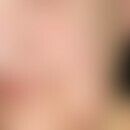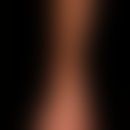HistoryThis section has been translated automatically.
In 1864, Albrecht von Graefe (1828 - 1870) was the first to describe the receding of the upper eyelid when the gaze is lowered downward as part of an endocrine orbitopathy (Rohrbach 2020).
DefinitionThis section has been translated automatically.
A Graefe's sign is the receding of the upper eyelid when the gaze is lowered (Herold 2022), so that the upper limbus appears exposed (Dennis 2019).
You might also be interested in
ClassificationThis section has been translated automatically.
"Eyelid lag" is when the upper eyelid stays back when looking down. This can occur:
- in the context of an endocrine orbitopathy and is then called a "Graefe's sign".
- as a side effect of ptosis surgery
- in congenital ptosis (Grajewski 2022)
General informationThis section has been translated automatically.
- Performance of the examination:
One has the patient fixate an index finger while performing a circular movement of the index finger from top to bottom (Holldack 2005).
The specificity of the Graefe's sign is 99% and the sensitivity is 19%. The positive likelihood ratio is 31.5% for Graves' disease (Dennis 2019).
Graefe's sign, together with Stellwag 's sign (infrequent blinking [Mattle 2008]), Dalrymple 's sign (retraction of the upper eyelid with scleral crescent [Kampig 2014]), and Möbius ' sign (convergence disorder [Mattle 2008]), are among the 4 classic ocular signs of endocrine orbitopathy (Kampig 2014).
EtiologyThis section has been translated automatically.
In the context of endocrine orbitopathy, Graefe's sign occurs as an early and important sign (Reiß 2009).
PathophysiologyThis section has been translated automatically.
The mechanism of the Graefe's sign has not yet been conclusively clarified. A combination of several factors is suspected (Dennis 2019).
Differential diagnosisThis section has been translated automatically.
- Pseudo Graefe's sign (Kampig 2014)
Here, a unilateral eyelid elevation occurs when looking downward. The cause is synkinesia of the eyelid after lesion of the oculomotor nerve (Hufschmidt 2017).
LiteratureThis section has been translated automatically.
- Dennis M, Bowen W T, Cho L (2019) Understanding symptoms: interpreting clinical signs. Elsevier Urban and Fischer Publishers Germany 551.
- Grajewski R S (2022) FAQ ophthalmology: answers - concise and practical. Elsevier Urban and Fischer Publishers 81
- Herold G et al (2022) Internal medicine. Herold Publishers 764
- Holldack K, Gahl K (2005) Auscultation and percussion - inspection and palpation: textbook and audio cassette with auscultation examples. Georg Thieme Verlag Stuttgart / New York 29
- Hufschmidt A, Rauer S, Glocker F X (2017) Neurology compact for clinic and practice. Georg Thieme Verlag Germany 69
- Kampig A, Grehn F, Messmer E M (2014) Specialist examination in ophthalmology: 1000 annotated examination questions. Georg Thieme Verlag Stuttgart 59, 265
- Kasper D L, Fauci A S, Hauser S L, Longo D L, Jameson J L, Loscalzo J et al (2015) Harrison's Principles of Internal Medicine. Mc Graw Hill Education
- Mattle H, Mumenthaler M (2008) Neurology. Georg Thieme Verlag Stuttgart 247
- Reiß M (2009) Facharztwissen HNO- Heilkunde: Differenzierte Diagnostik und Therapie. Springer Verlag Berlin / Heidelberg 426
- Rohrbach J M (2020) On the 150th anniversary of the death of Alfred von Graefe (1828 - 1870): The conscience of ophthalmology in Germany. Springer Verlag Germany 30




